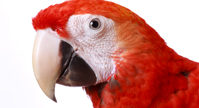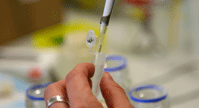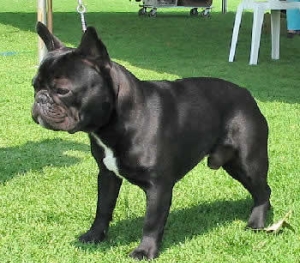A-Locus
(Fawn/Sable, Tricolor/Tan Points, Solid Black)
Description:
There have been four different alleles identified in a dog’s genes that signal the agouti coloration (this coloration can be exemplified as the coloration of the wild brown rabbit), also known as the A locus. If you’d like to learn more about the difference between an allele and a gene, click here. These alleles are Ay, aw, at, and a.
These alleles are dominant in a hierarchy. This means that Ay is more dominant than aw, aw is more dominant than at, and at is more dominant than a. For example, if a dog is Ay/at, the color associated with Ay will appear on the dog, rather than the color associated with at. However, this is all dependent on whether or not the dog carries the dominant black gene at the K locus or the recessive gene on the E locus. If a dog carries one or both of these genes, the A locus is muted and the agouti coloration will not appear on the dog. This is because both the K locus and the E locus are dominant over the A locus.
The agouti gene (A Locus) determines the base coat color in dogs that are ky/ky for dominant black. Dogs must be ky/ky in order to express any alleles on the A locus. The color of the dog can still be modified by other genes, such as by the B locus or D locus, however. For example, if a dog is b/b (recessive) for the B locus, they will still have areas that are pigmented as black. However, it will be modified to appear as a chocolate pigment.
However, if a dog’s A locus codes for the fawn coloration and the dog is b/b for the B locus, the fawn dog will have a chocolate nose. In contrast, a dog that is at/at will have a chocolate and tan coat, rather than black and tan. If a dog is n/n for the gene, that means that the dog is recessive for this gene and the typical colors associated with the pattern are not expressed. This is a generic term used to refer to the expression of any coat color.
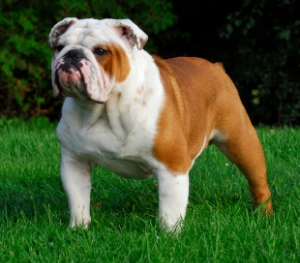
The "Ay" Allele
The Ay allele is the most dominant of all four alleles on the A locus. The Ay gene produces a range of coat colors like light fawn colors, darker red colors, or even sable. This variation of color is due to variances in the expression of this gene. Dogs that are ky/ky for the K locus and have one or two copies of the Ay allele will always express the Ay coat pattern. This is because the Ay allele is more dominant than the ky allele expression. It is important to note, however, that a dog can appear as fawn or sable and could also carry any other of the three alleles. These other alleles, however, would not be expressed, and a person wouldn’t be able to tell the dog had the ability to produce other traits based on looks.
This does not mean that the dog with a fawn coat (Ay) will always pass on a copy of the Ay allele or the coat color that the parent has. A dog that is Ay/aw, Ay/C, or Ay/a has a 50% chance of passing on the Ay allele and a 50% chance of passing on the other alleles. A dog that has two copies of the Ay allele will always pass on the Ay allele. As long as that dog is bred to another dog that is n/n (recessive) for the K locus, the dog will always produce fawn or sable pups.
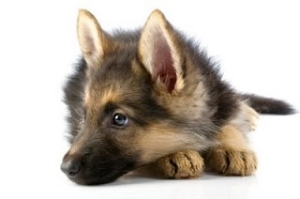
The "aw" Allele
The aw allele produces a color known as "wild sable." This coat coloration is sometimes called the "wild type," or in some breeds, "wild boar." With this coloration, the hairs switch pigmentation from a black color to a reddish or fawn color. This color is sometimes seen in German Shepherds and other shepherd breeds. It is recessive only to the Ay allele. This also means that it is dominant to the at and a alleles, and will be expressed before the at and a alleles. If a dog is n/n for the Ay allele (meaning this allele is not expressed), a dog with one or two copies of the aw allele will express the aw coloration. A dog that is n/n for Ay and has one copy of the aw allele can carry either the at or a allele and not express them. However, even though the at and a alleles do not appear as a trait on the coat, either allele can be passed to any offspring.
The "at" Allele
Both the black-and-tan and tricolor phenotypes (expressed traits) are caused by the at allele. A tricolor dog is black-and-tan, with white. White is generally just an absence of color, rather than a pigment the dog expresses. For a dog to be black-and-tan or tricolor, he must be n/n for the dominant black gene (the K locus). This means that the K locus is not expressed, and the dog will not be black. Furthermore, the dog must have either two copies of the at allele, or have one copy of the at allele and one copy of the a allele. The dog must be n/n for both the ay and aw alleles in order for at to be expressed. This is because the Ay and aw alleles are dominant over at. A dog that is at/at will always pass on a copy of the at allele to any offspring. This does not ensure that the puppies will be black-and-tan. The coat color of the offspring also depends on the genotype of the other parent.
The "a" Allele
If a dog is ky/ky on the K locus, the dog must be n/n for Ay, aw, and at in order for the dog to express the a/a coloration. A dog that is solid black with the recessive K locus must also have the recessive a/a allele in order to express the black coloration. It is important to make this distinction because a dog can also be solid black with kB/kB or kB/ky under the K locus. The A locus is not needed for this type of dog. Therefore, this type of black dog does not need the a/a coloration in order to express the black color. You can learn more about this type of dog by reading about the K locus or the B locus.
This is also the case for dogs that are bicolor and are negative for the K locus (ky/ky). This is generally the cause of a solid black German Shepherd. The a allele is sometimes referred to as the recessive black gene. Because this allele is the most recessive, for a dog to express this phenotype he must have two copies of the a allele and be n/n for Ay, aw, and at. A recessive black dog will always pass on the a allele to all offspring.
| Genotype | Coat Color | Hidden Color |
|---|---|---|
| Ay/Ay | Fawn/Sable | None |
| Ay/aw | Fawn/Sable | Wild Sable |
| Ay/at | Fawn/Sable | Tricolor/Tan Points |
| Ay/a | Fawn/Sable | Solid Black/Bicolor |
| aw/aw | Wild Sable | None |
| aw/at | Wild Sable | Tricolor/Tan Points |
| aw/a | Wild Sable | Solid Black/Bicolor |
| at/at | Tricolor/Tan Points | None |
| at/a | Tricolor/Tan Points | Solid Black/Bicolor |
| a/a | Solid Black/Bicolor | None |
In most dog breeds the Agouti gene is only visible if the dog does not carry the dominant black gene. The dog can still carry any of the agouti alleles. However, this effect is usually hidden by the dominant black gene.
A Locus Testing:
Animal Genetics currently offers tests for the "Ay", "at", "aw" and "a" allele. Dogs can be DNA tested at ANY age.
Sample Type:
Animal Genetics accepts buccal swab, blood, and dewclaw samples for testing. Sample collection kits are available and can be ordered at Canine Test Now.
Testing Is Relevant for the Following Breeds:
All breeds.
Results:
Animal Genetics offers DNA testing for all alleles individually, or all four together for a comprehensive A-Locus genotype. The genetic test verifies the presence of the dominant or recessive allele and presents results as one of the following:
ay-Allele Results:
| Ay/Ay | The dog carries two copies of the dominant Ay allele. In most breeds the dog will have a fawn or sable colored coat if ky/ky and will always pass on the "Ay" allele to any potential offspring. All offspring will also be fawn or sable dogs if bred to another ky/ky dog. |
| n/Ay | One copy of the dominant Ay allele is present. The dog will have a fawn or sable coat color if ky/ky and can pass on either allele to potential offspring. |
| n/n | The dog does not carry the Ay allele, and will not have a fawn or sable coat pattern. |
aw-Allele Results:
| aw/aw | The dog carries two copies of the wild sable allele. The dog, if ky/ky, will exhibit the wild sable phenotype, and will always pass on the wild sable allele to any offspring. |
| n/aw | One copy of the aw allele is present. The dog can pass on either allele to potential offspring. |
| n/n | The dog does not carry the aw allele, and will not have a wild sable coat pattern. |
at-Allele Results:
| at/at | The dog carries two copies of the at allele. The dog will have a black and tan or tricolored coat if the dog is ky/ky and will always pass on the at allele to any potential offspring. |
| n/at | One copy of at allele. If Ay/at the dominant Ay allele will show. If aw/at the dominant aw allele will show. If a/at the dominant At allele will show. The dog will pass on either allele to potential offspring. |
| n/n | The dog does not carry the at allele, and will not have a black and tan or tricolored coat pattern. |
a-Allele Results:
| a/a | The dog carries two copies of the recessive solid black allele "a". The dog will have a solid black or bicolor coat, and will always pass on a copy of the allele to future offspring. |
| n/a | Only one copy of the recessive solid black allele is present. The dog will not express the recessive black coat color. However, the dog can still pass on a copy to any offspring. |
| n/n | The dog does not carry the recessive solid black allele. The dog will not express the recessive black coat color and cannot pass it on to any offspring. |
Submit a Sample for Testing:
To submit a sample for testing please go to Canine Test Now.
To order a sample collection kit please go to Order Sample Collection kits.
Cost per sample is $40.00. Please see our Canine Fee Schedule for all test rates.


